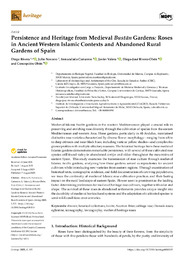Please use this identifier to cite or link to this item:
https://hdl.handle.net/11000/38290Full metadata record
| DC Field | Value | Language |
|---|---|---|
| dc.contributor.author | Rivera, Diego | - |
| dc.contributor.author | Navarro, Julio | - |
| dc.contributor.author | Camarero, Inmaculada | - |
| dc.contributor.author | Valera, Javier | - |
| dc.contributor.author | Rivera Obón, Diego José | - |
| dc.contributor.author | Obón, Concepción | - |
| dc.contributor.other | Departamentos de la UMH::Biología Aplicada | es_ES |
| dc.date.accessioned | 2025-11-18T12:29:05Z | - |
| dc.date.available | 2025-11-18T12:29:05Z | - |
| dc.date.created | 2025 | - |
| dc.identifier.citation | Heritage 2025, 8, 315 | es_ES |
| dc.identifier.issn | 2571-9408 | - |
| dc.identifier.uri | https://hdl.handle.net/11000/38290 | - |
| dc.description.abstract | Medieval Islamic bust¯an gardens in the western Mediterranean played a crucial role in preserving and enriching rose diversity through the cultivation of species from the eastern Mediterranean and western Asia. These gardens, particularly in Al-Andalus, maintained distinctive rose varieties characterized by diverse flower morphology—ranging from white to deep crimson and near-black hues, including various yellow shades—and complex fragrance profiles with multiple olfactory nuances. The botanical heritage from these medieval Islamic gardens demonstrates remarkable persistence, with several of these cultivated rose species still found today in abandoned cortijos and aldeas throughout the mountains of eastern Spain. This study examines the transmission of rose culture through medieval Islamic bust¯an gardens, analyzing how these gardens served as repositories for ancient cultivars while introducing new varieties from eastern regions. Through examination of historical texts, iconographic evidence, and field documentation of surviving populations, we trace the continuity of medieval Islamic rose cultivation practices and their lasting impact on the rural landscape of eastern Spain. Flower scent is prominent as the leading factor determining preferences for medieval heritage rose cultivars, together with color and shape. The survival of these roses in abandoned settlements provides unique insight into the durability of medieval horticultural systems and the adaptation of cultivated species to semi-wild conditions over centuries. | es_ES |
| dc.format | application/pdf | es_ES |
| dc.format.extent | 32 | es_ES |
| dc.language.iso | eng | es_ES |
| dc.publisher | MDPI | es_ES |
| dc.rights | info:eu-repo/semantics/openAccess | es_ES |
| dc.rights | Attribution-NonCommercial-NoDerivatives 4.0 Internacional | * |
| dc.rights.uri | http://creativecommons.org/licenses/by-nc-nd/4.0/ | * |
| dc.subject | almunia | es_ES |
| dc.subject | botanical collections | es_ES |
| dc.subject | bust¯an | es_ES |
| dc.subject | Austrian Briar | es_ES |
| dc.subject | cabbage rose | es_ES |
| dc.subject | Damask roses | es_ES |
| dc.subject | eglantine | es_ES |
| dc.subject | iconography | es_ES |
| dc.subject | lexicography | es_ES |
| dc.subject | medieval heritage roses | es_ES |
| dc.title | Persistence and Heritage from Medieval Bust¯an Gardens: Roses in AncientWestern Islamic Contexts and Abandoned Rural Gardens of Spain | es_ES |
| dc.type | info:eu-repo/semantics/article | es_ES |
| dc.relation.publisherversion | https://doi.org/10.3390/heritage8080315 | es_ES |

View/Open:
Rosas heritage-08-00315-v2.pdf
3,11 MB
Adobe PDF
Share:
.png)
